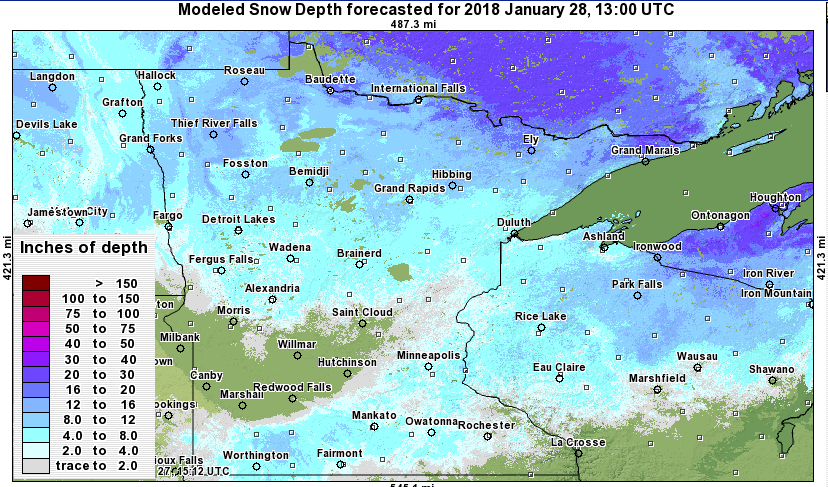
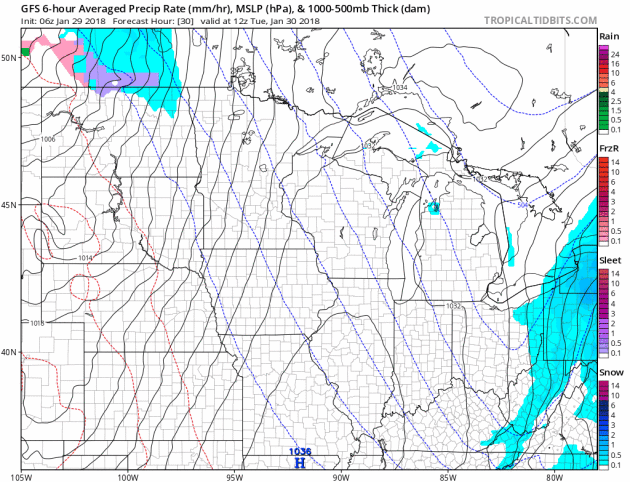
Snowfall Potential – NWS Forecast
.png)
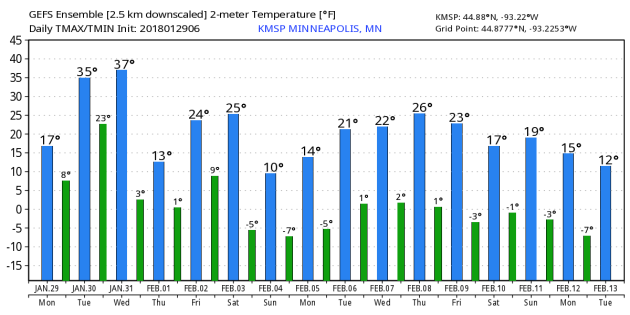
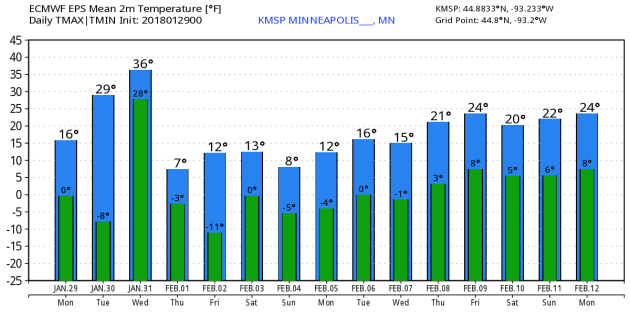
_____________________________________________________________________________
Snow Depth 2018

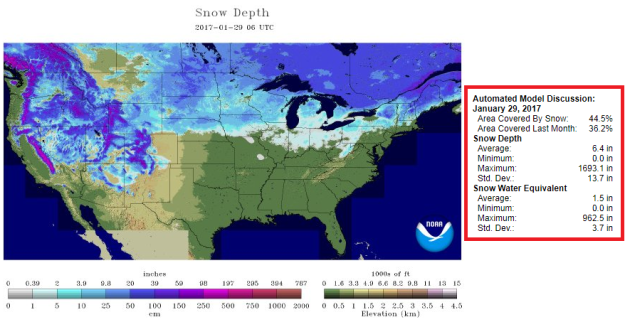
____________________________________________________________________________


General Ice Thickness Guidelines
Under 4″ – STAY OFF
4″ – Ice fishing or other activities on foot
5″ – 7″ – Snowmobile or ATV
8″ – 12″ – Car or small pickup
12″ – 15″ – Medium truck
Many factors other than thickness can cause ice to be unsafe.
White ice or “snow ice” is only about half as strong as new clear ice. Double the above thickness guidelines when traveling on white ice.
___________________________________________________________________
.png)

“Groundhog Day 2018: 5 bizarre things you didn’t know about this quirky tradition”
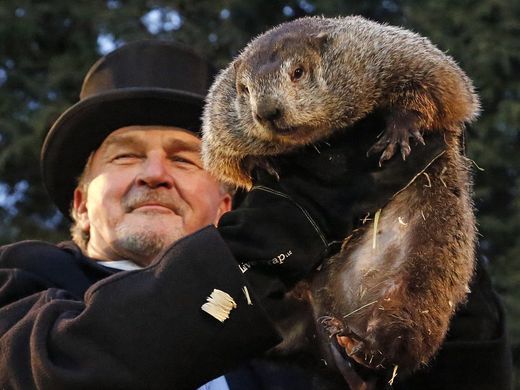
First things first. Here’s a look at weather conditions across the nation on Tuesday. Temps in the Eastern US will be running a little bit below average, but the western two-thirds of the country looks to be quite mild with temps running nearly 15F to 25F above average.
“When Hurricane Harvey dropped up to 60 inches of water over southeastern Texas, who would have guessed the state would be experiencing a drought less than half a year later? Certainly not John Nielsen-Gammon, the state climatologist and a professor at Texas A&M University. He’s been Texas’ climatologist for nearly 20 years, and he didn’t expect a drought to follow Hurricane Harvey. That being said, it’s not like he’s exactly surprised, either. After all, drought is a normal occurrence in the state. This type of event typically follows La Niña, and that’s what the Tropical Pacific is currently experiencing. During La Niña, which sees a cooling effect throughout the Pacific, Texas sees drier and warmer conditions. That means less rain. The thing that gets Nielsen-Gammon, however, is that the dry winter extends back to September. La Niña, on the other hand, doesn’t begin until November.”

_____________________________________________________________________________Weather Outlook Ahead
.gif)
According to NOAA’s WPC, the 5-day precipitation outlook suggests areas of heavy precipitation continuing in the Eastern US, while the heaviest will continue in the Pacific Northwest. Some spots in the Olympics, northern Cascades and on Vancouver Island could see as much as 4″ to 8″+ liquid! Unreal.
.gif)
Snowfall Potential Ahead
.png)
By Todd Nelson, filling in for Douglas
According to a recent report from NOAA, 2017 was the 3rd hottest on for the entire globe, while the world’s oceans were the hottest ever recorded. Good grief! Alaskans also just experienced its warmest December on record with a staggering statewide average anomaly of 15.7 degrees… what’s going on?
If you’re keeping track, Minnesota’s weather is changing too. Dr. Kenny Blumenfield from the MN DNR State Climatology Office suggested that there are three noticeable trends happening in the state; 1.) Minnesota is becoming warmer and wetter. 2.) Wintertime, nights and cold extremes are warming fastest. 3.) Heavy and extreme rainfall is increasing.
Chew on that for a while.
A fast moving clipper will scoot through the region Tuesday with a few inches of snow across the international border. Other than a light coating, MSP won’t see much later today. It will be windy though!
Temps tumble late Wednesday with face-numbing wind chills in play by the end of the week. Light fluffy snow arrives once again Friday night into Saturday.
________________________________________________________________________
Extended Forecast
TUESDAY: Windy. Light PM snow. Winds: SE 15-30. High: 29.
TUESDAY NIGHT: Light snow coating. Then decreasing clouds. Winds: SSE 5-15. Low: 25
WEDNESDAY: Brighter blue sky. Temps tumble late. Winds: WNW 10-15. High: 32.
THURSDAY: Brisk winds. Face-numbing again. Winds: NW 10-15. Wake-up: 0. High: 7.
FRIDAY: Cold start. Cloudier PM, snow at night. Winds: SSE 5-10. Wake-up: -6. High: 11.
SATURDAY: Snowy start. Fluffy coating possible. Winds: N 10-15. Wake-up: 2. High: 14.
SUNDAY: Chilled sunshine. Less wind. Winds: W 5-10. Wake-up: -2. High: 8.
MONDAY: Another light snow chance. Winds: SW 5-10. Wake-up: 0. High: 12.
_______________________________________________________
This Day in Weather History
January 30th
1994: Duluth has a record low of -35.
_______________________________________________________
Average High/Low for Minneapolis
January 30th
Average High: 25F (Record: 48F set in 1989)
Average Low: 8F (Record: -30F set in 1887)
Record Rainfall: 0.49″ set in 1878
Record Snowfall: 6.4″ set in 2014
_________________________________________________________
Sunrise/Sunset Times for Minneapolis
January 30th
Sunrise: 7:34am
Sunset: 5:18pm
Hours of Daylight: ~9 hours & 43 minutes
Daylight GAINED since yesterday: ~ 2 minutes & 30 seconds
Daylight GAINED since winter solstice (December 21st): 57 minutes
__________________________________________________________
Moon Phase for January 30th at Midnight
0.3 Days Until Full “Snow” Moon
“Usually this title is reserved for a full moon in February, since world tends to be fully coated in snow by then. But this year is an oddity, in that there will be no full moon in February. (This is true for most locations on Earth, but in some places, including eastern Asia and eastern Australia, the moment of peak fullness will occur on the morning of Feb. 1.) During February, the snow and bitter cold makes hunting difficult, so some tribes called this moon the Full Hunger Moon.
This is the second time the moon turns full in a calendar month, so it is also popularly known as a Blue Moon. On average, full moons occur every 29.53 days (the length of the synodic month), or 12.37 times per year. So months containing two full moons occur, on average, every 2.72 years. This year, however, is a striking exception to this rule, as you will soon see.
Jan. 31 will also be the night of a total lunar eclipse.The Pacific Rim — the lands around the rim of the Pacific Ocean— will have a ringside seat for this event: Totality will last 77 minutes, and at mideclipse, the moon will appear directly overhead (or nearly so) over the open waters of the western Pacific Ocean.
In the western U.S. and western Canada, the eclipse will take place during the predawn hours, but across the rest of North America, the progress of the eclipse will be interrupted by moonset.
.gif)
_________________________
“How Rare Is The All-In-One Supermoon, Blue Moon, And Lunar Eclipse, Really?”
“This January 31st, something quite rare and special will happen. At 1:30 PM, Universal Time (8:30 AM Eastern / 5:30 AM Pacific), the Moon will reach its full phase for the second time in the month of January, making it a blue Moon. The full Moon also occurs very close to perigee, where the Moon makes its closest approach to Earth in its elliptical orbit, occurring close enough to create a Supermoon, where the full Moon is up to 14% brighter than average. And finally, the Moon will fully slip into the Earth’s shadow during this time, creating a total lunar eclipse. NASA is calling it the “Super Blood Blue Moon.” For observers in North America, it’s the first time all three of these phenomena will line up since 1866. But how rare is it, really, to get a Supermoon, blue Moon, and lunar eclipse all at once?”
_______________________________________________________________________________Temp Outlook For Tuesday
Here’s the temperature outlook as we head into the 2nd week of February, which suggests that colder than temperatures will be in place across much of the region. While temperatures will likely be colder than average, it doesn’t appear to have as big of a bite that it had at the end of December and early January.
8 to 14 Day Temperature Outlook
As we head into the 2nd week of February, warmer than average temperatures will still be in place across the Southwestern and Southeastern US, while much of the central and northern part of the nation will still be running below average.

__________________________________________________________________________

_____________________________________________________________________________
________________________________________________________________________________
______________________________________________________________________________
____________________________________________________________________________

___________________________________________________________________________
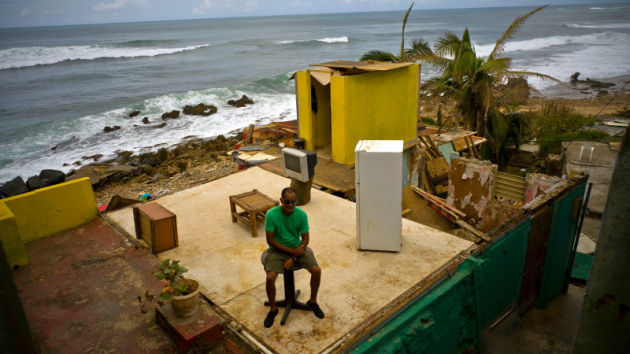
___________________________________________________________________________
“The Number of Billion-Dollar Weather Disasters in the U.S. Is Surging”
“Extreme weather is becoming more common, and the economic impact is soaring. Last year there were 16 weather events in the U.S. that caused at least $1 billion each in damage, according to the National Oceanic and Atmospheric Administration. The cumulative cost was $306 billion—easily surpassing the previous one-year record of $215 billion set in 2005. In September a report from the nonprofit Universal Ecological Fund, “The Economic Case for Climate Action in the United States,” estimated that total climate-related economic losses and health costs in the U.S. averaged $240 billion a year over the past decade. The authors project the annual cost will rise to $360 billion over the next 10 years.”

____________________________________________________________________________“CAPE TOWN’S WATER CRISIS IS SO SEVERE, EVEN LUXURY TOURISTS ARE FEELING IT”
“For people who know it, Cape Town is a city that can feel defined by its mind-boggling levels of inequality. But for travelers being catered to by the city’s sophisticated luxury travel market, Cape Town’s rampant challenges often stay shielded from view. However, the city’s increasingly severe water crisis—which has Cape Town officials warning that “Day Zero,” when the city will turn off its taps, could come as soon as late April—is a reality that even the city’s finest hotels aren’t shielding their guests from. In fact, as a whole, five star and ultra luxury properties are responding to the crisis with an urgency that is somewhat surprising—especially when you consider the types of wealthy guests they generally serve.”

______________________________________________________________________________
Thanks for checking in and don’t forget to follow me on Twitter @TNelsonWX


